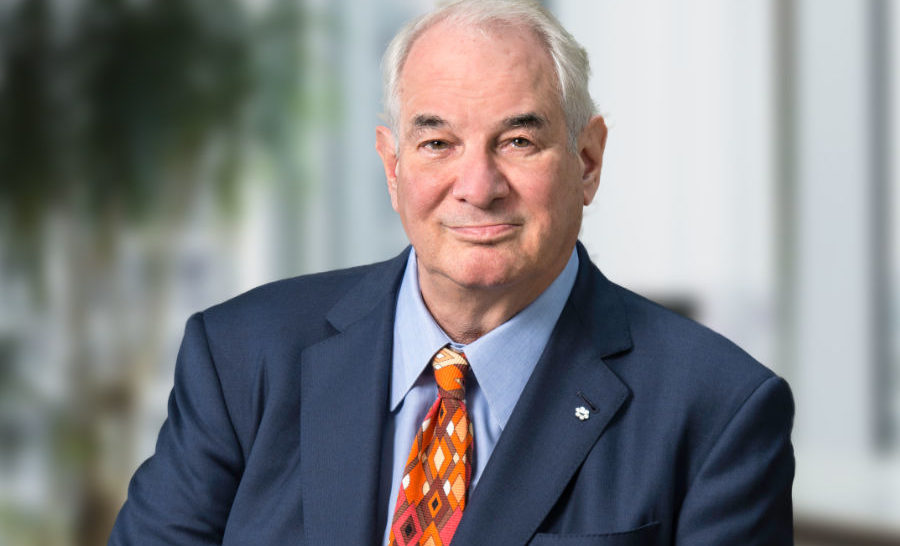Clayton Ruby, who took on cases that changed the Canadian legal landscape, died Aug. 2 at the age of 80. Brian Shiller, his legal partner and long-time friend, delivered this eulogy at his funeral Aug. 9.
In 1970, a 28-year-old, first-year lawyer named Clayton Charles Ruby was interviewed by Maclean’s magazine about his quickly developing reputation as a lawyer for the radical youth of the day. The newly minted lawyer had this to say about his clients:
“I’m defending those so-called ‘radicals’ because, in many ways, I think what they are doing is more important than what I am doing. If change is going to come, I am convinced it will have to be from the streets, not from the courts. For the radicals, freedom is not a textbook matter. They are testing the limits of those freedoms in the streets. Where else should a lawyer be?”
Clay experienced the heavy hand of the state himself. Five years earlier, while a summer student at Harvard University, he and his friend John Seeley were out for ice cream one evening and, as John tells it “We drifted into a fracas with brutal cops and then a racist court.”
Clay was approached by a white police officer and told to disperse. The 23-year-old explained that he was a law student and had a constitutional right to protest. Clay was promptly arrested and hauled off to jail.
And what was his reaction to being arrested and jailed? He told his friend Michael Valpy this: “I sat on this cold, cold, steel slab… and I realized it was precisely the place I wanted to be at that moment. The most important place on Earth to be. I just knew it.”
And so began a half-century battle for justice and equality that ended on August 2nd, when Clay passed away at the age of 80.
He grew up in an affluent Toronto neighbourhood and by most accounts, he was a smart-ass kid who drove his teachers crazy. He was kicked out of his synagogue for being “a disrespectful miscreant.”
He was also brilliant, but young, and trying to find his way.
He went to York University and obtained a degree in philosophy.
He entered law school at the University of Toronto in 1964. He was skeptical that law school was the best way to tackle the serious issues of the day and was not sure if he wanted to continue after his first year.
He was idealistic. He said at the time “I had ideas of bringing about legal reform, but meaningful change just isn’t about to happen.”
Despite his reluctance, following that summer in Boston, he returned to the University of Toronto to continue his studies.
Those legal studies coincided with a growing movement for social change that was continuing to fester in Yorkville which was being rapidly populated by young hippies and draft dodgers.
It was the fall of 1966, and David DePoe, the son of a prominent journalist, came on the Yorkville scene to organize humanitarian efforts. He put together a group of like-minded individuals and called them the ‘Diggers’ who ministered to the needs of Yorkville’s hip youth.
The core group of Diggers included law students Paul Copeland and Clay Ruby. The Diggers rapidly became the public face of the Yorkville scene.
Clay and Paul started the “Village Bar” where they dispensed legal advice to hippies and draft dodgers on the sidewalk outside the Grab Bag, a convenience store in Yorkville.
By the time Clay had been called to the bar in 1969, he had provided legal advice to countless young people in Yorkville who were constantly harassed by police.
Then Clay had an idea. As Paul explained “we were giving out so much legal advice that Clay decided we should write a book to cover the issues of the day.”
Paul and Clay wrote Law Law Law. As Clay explained it:
“We wanted to clear up some myths. For example, legally, there’s no such order as ‘Come along to the station, we want to talk to you.’ But many people don’t know that. Fair play might prevail if you don’t know the law, but it’s much more likely if you do.”
In its first six months of publication, 11,000 copies of the book were sold, and it went on to sell 60,000 copies.
Clay and Paul then started a law firm. After a few years, Clay decided to do a master’s degree at the University of California (Berkeley). He graduated in 1973.
Clay then moved to 11 Prince Arthur—an address that would become home to many notable lawyers. It became the home and meeting place of Clay’s law family and a brain-trust of like-minded lawyers who wanted to make a difference. It was also a stepping-stone to the bench. No less than a dozen lawyers who worked out of 11 Prince Arthur became judges.
In 1976, Clay and Marlys Edwardh started Ruby Edwardh. Marlys was just a first-year lawyer at the time. She told me yesterday “In those days, women were not criminal lawyers, and I knew I wanted to be one. I went to see Clayton to plead my case. He must have found me persuasive because he said, ‘you’re hired’.”
Marlys and Clay went on to be a formidable force and no one contributed more to shaping the law and challenging authority.
Justice Michael Code remembers those years with great fondness: “Together with Mel Green, I articled for Clay when Ruby Edwardh started. After us came Frank Addario. With the advent of the Charter, Clay finally had his tool to attack the way the criminal justice system approached the law. He was very much schooled in the American tradition and the Charter absolutely played to his strengths. It seemed like we were heading to the Supreme Court every other month to argue yet another important issue that went to the heart of the rights of accused people to receive a fair trial.”
And that tradition didn’t stop. As Justice John Norris told me: “I articled for Clay and Marlys in the early 1990s and stayed on at 11 Prince Arthur for another 15 years. The confluence of brilliant lawyers there was simply staggering. I still cannot believe my good fortune to have begun my legal career at the forefront of some of the most important legal battles in Canada and to have been mentored by Clay and Marlys, each in their distinctive ways. It was also the one and only time I have driven an Aston Martin.”
For decades, reception was run by Morag who greeted clients with charm, elegance, and sophistication. Once, a walk-in prospective client asked to speak to a lawyer explaining that he had just murdered his wife. Morag said “I agree, you do indeed need to speak to a lawyer.”
Together with countless great legal minds, Clay handled some of the most high-profile and important cases in the country.
And his clients were so lucky to have him as their advocate. As his dear friend and colleague Frank Addario told me: “He was the most curious, legally creative lawyer I have known.”
He was creative indeed. He represented the Dionne quintuplets in their quest for compensation from the provincial government. I recall two moments from that case.
The first, is when I offered to draft a lawsuit for the Dionnes, Clay said “No lawsuits. I am going to ask the Dionnes to sit at the corner of Yonge and Dundas begging for money with tin cups. The media will take it from there.”
My second memory is of then-Attorney General Charles Harnick awkwardly climbing the stairs of 11 Prince Arthur to try and settle with Clay. I may be mistaken, but I swear the Attorney General had a cheque book in his hand.
He was also very sensitive to the needs of his clients. He had incredible compassion and empathy for them.
Mandy Machin was Clay’s executive assistant for more than three decades. She managed the mayhem, dealt with the clients, made sure Clay had everything he needed, and experienced first-hand his approach to clients. She told me this:
“When someone retained Clay, they had his undivided attention. He would hand them his business card and write his mobile and home numbers on the back. He would tell them, ‘If you have any questions, call me, day or night and I will put your mind at ease.’
Many times, I witnessed him expressing his concern for the mental health of his clients. He would say ‘I am worried about you, I am going to give you some names, you need help and there is no shame in that.’”
One of the many cases that had a profound impact on the law was that of Michelle Douglas v. Canada. Despite constant advancement in her career, in 1989 Ms. Douglas was discharged from the military for being “not advantageously employable due to homosexuality”.
She heard Svend Robinson speak at a conference and he brought her to Clay. Together with Harriet (his wife Justice Harriet Sachs), Clay launched an action against the military and after battling for three years, the federal government was ordered to compensate Ms. Douglas and the court ruled that men and women could no longer be barred from the military because of their sexual orientation. This led to equal benefits for same-sex couples in 1999 and the legalization of same sex marriage in 2005.
Michelle Douglas was terrified to be the face of this court challenge. When asked about her thoughts following his death, Michelle Douglas said this: “Clay was a kind and gentle person with me. He supported me, was very generous and compassionate towards me, and told me that through this case I could help others.”
And while he had a diverse clientele, it was the breadth of cases that was astonishing. This is what Justice Jill Copeland remembers: “The variety of work one could do working with Clay was endless. First degree murder appeal? Check. Criminal trial about the free speech rights of women to protest topless? Check. Civil injunction to protect the right of women to access abortions? Check. Constitutional reference about federal firearms legislation? Check. Fighting for the equality rights of gays and lesbians in the military? Check. Animal rights cases involving circuses, seals, and baby bears? Check. A case involving actual Russian sleeper agents? Check.”
The most common sentiment from those who worked with him was that Clay was incredibly inclusive. There is no shortage of ego when it comes to taking the lead in court. And yet, Clay always divided up the work.
Justice Breese Davies had this observation: “On my first day at the firm, Clay told me I was arguing a case with him the next Monday and another on Friday and I should pick issues to argue. I had to say ‘Well, I can argue Friday, but I can’t on Monday because I don’t get called to the bar until Wednesday.’ Clay said, ‘OK. Come to the hearing with me on Monday and you’ll argue on Friday.’ Then when I came to the office after my call on Wednesday, Clay had made sure my name was already on the door.”
Gerald Chan recounts that when he was a second-year lawyer, he had the opportunity to go to the Supreme Court with Clay. Having recently clerked for Justice Rosalie Abella, he really wanted the opportunity to get up in front of the panel for just a few minutes. Perhaps one small issue.
He sheepishly broached the subject. Clay’s response: “Of course, you’re going to argue half the appeal. We are colleagues.”
There was this misconception that Clay had a big ego. In fact, he had no ego. He did not have to be the one to affect change. It did not matter who was taking the lead, only that the job was done right. You see, it was never about him, it was always about the client, the legal principle, the injustice, the desire to achieve positive change.
When those cameras turned on at the myriad of press conferences he held, he wanted to ensure he was doing whatever he could for his client. Full stop. The media was a megaphone to the people for Clay. And he used it masterfully. He was the king of the sound bite and the OG of social media.
His generosity and caring extended beyond his own law firm in significant ways.
He had an incredible capacity for resolving ethical issues confronting other lawyers. Clay could be hard at work at his little desk in that greenhouse he called an office, only to be interrupted by a call from a frantic lawyer struggling with an ethical issue needing resolution.
He would drop everything and give candid, caring advice. He considered it his duty. One of those lawyers wrote me last week after hearing of Clay’s passing and said, “Clay gave me back my life, and I have tried to pay it forward every day since then.”
And that is precisely what Clay would want him to do.
He was also a bencher—for more than 40 years. He has the unimaginable distinction of being the longest-serving bencher in the Law Society’s 225-year history. That feat is all the more incredible when you consider that he was, as the Globe and Mail put it—“widely perceived as a left-wing burr in the saddle of the establishment.”
Clay had an explanation for his string of election victories: “I know, it’s weird that a perennial critic gets elected year after year, but I’m grateful for it. I think that people want to know there is somebody on the inside, questioning authority.”
And he did question that authority from within constantly. And he was highly respected by those establishment lawyers who saw that he was very polite but forceful in his views.
They even gave him dominion over the Law Society wine cellar.
In 2005 the burr in the saddle of the establishment was named acting treasurer of the Law Society.
In 2006, he was awarded the Order of Canada.
The Order of Canada designation was a very big deal to him. Remember, he was a miscreant. He fought the system. He championed causes that the establishment ignored. That honour signified to him that his country was proud of him for what he had done. It was a recognition of his hard-fought battles in the trenches. You can be a miscreant and a great Canadian.
Clay felt this urge to constantly demand change. He wrote dozens of letters-to-the editor highlighting one injustice after another. Eventually, both the Toronto Star and the Globe and Mail gave him his own columns.
Clay’s legacy will live on through his firm. Today, the firm is made up of brilliant young women who seek to carry on his work, challenging the system and fighting injustice.
His legacy also lives on through his seminal text Sentencing. It is in its 10th edition and is the go-to text for lawyers and judges alike.
Clay’s obituary says: “In lieu of donations, go out and change the world.”
Indeed, the best way to honour Clay’s legacy is to continue it. There are many Guy Paul Morin’s and Donald Marshall’s out there who need a leveled playing field to achieve justice or where justice fails, to breach the barricades and challenge the system.
While there have been improvements in equality rights, there are still many people like Michelle Douglas who need strong and zealous advocates to take up the charge.
In a time where legal aid pays pennies to defence lawyers, and the state has unlimited resources, we need more Clayton Rubys to step up and challenge the system and demand change. If you want to honour Clay’s memory, get out there and make a positive difference.
I’ll let Clay have the last word in a message to young lawyers from 2019: “Let me end with an incongruously religious note. Over the course of your career, you are going to encounter many difficult problems. I certainly have. It’s helpful to keep in mind this verse from the Old Testament, which, in my view, captures the essence of Judaism: ‘Do justice, love kindness and walk humbly with thy God.’ It’s that simple.”
Rest in Power, Clay.







